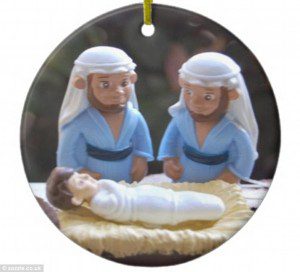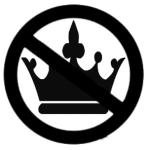Here’s an interesting little item from a British newspaper about a controversial Christmas tree ornament:
A gay Christmas decoration showing a nativity scene with two Josephs has been slammed by outraged Christians.
The colourful hanging tree ornaments – on sale for £13 – also have a lesbian version with two Virgin Marys sitting beside a baby Jesus Christ, who is lying in a manger.
I’m going to go ahead and say this is a bad idea. It’s not good art. It’s probably not good commerce. However historically accurate the biblical birth narratives are, these ornaments are not historically accurate. They are designed, I think, to encourage a marginalized group. But they are sure to offend many people. In fact, this story and a similar article in the Christian Post focus on the predictable reaction from a conservative religious group called Christian Concern. Its chief executive said, “‘They blasphemously portray the Lord Jesus being parented by a homosexual couple. What depths will the LGBT lobby stoop to in order to try and normalise their behaviour?”
But this raises a question. After centuries of Western art portrayed the Lord as a light-skinned man (often with light hair), many Christian artists from other parts of the world began portraying Him with features unique to their own ethnic groups. I don’t think this caused any great outcry. (Please view and buy some amazing paintings from the Chinese Christian artist He Qi.)
If it’s okay to use art to deliberately make excluded groups feel included, then why not depict the Holy Family as anchored by a same-sex couple? Well, for a lot of reasons. First, there are the widely held theological beliefs about how Jesus (and (His Blessed Mother) were conceived. Nativity scenes are probably not the place for LGBT-inclusive gestures, theologically speaking. Why not have gay shepherds and leave Jesus’ mother and father alone?
I immediately thought about a key debate over conscience protections for traditionalists who wish to decline certain commercial transactions on religious grounds. If a baker would not be allowed to refuse to make a cake for an interracial wedding, why should he be allowed to decline to bake for a same-sex union? The argument goes something like this: Even if some religious people opposed interracial marriages, they did not deny that a marriage had indeed been formed. Whereas with same-sex weddings, conservatives do not want to recognize those unions as marriages. Race is basically arbitrary and not essential to identity as a human person, whereas sex is. There is no essential difference between a dark skinned man and a light skinned man. But there is an essential difference between a man and a woman. So the argument goes.
Thus a Nativity ornament with two Marys or two Josephs is a pretty deliberate provocation that is going to offend traditional Christians (and, I would assume, plenty of gay Christians), and not just because they are irrational bigots (which I do not believe they are).
The article continues:
Defending the gay and lesbian ornaments, Mr Thaler said: ‘Not everyone’s viewpoints are the same. People need to coexist and not judge one another.
‘It’s just an image. They need to focus on themselves and not worry about what everyone else is doing.’
Mr Thaler is now considering removing the decorations from sale ‘out of respect for his fellow humans’.
“Out of respect for his fellow humans.” Good idea. In my view, finding consensus about what respect for our fellow humans entails is one of the great challenges of our evolving notions about marriage, family, and equality.













